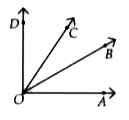Which of the following pair of angles are supplementary?
46∘and44∘
113∘and67∘
245∘and115∘
90∘and180∘
To determine which pair of angles are supplementary, we need to follow these steps:
Step 1: Understand the Definition of Supplementary Angles
Supplementary angles are two angles whose measures add up to 180 degrees.
Step 2: Check Each Pair of Angles
We will evaluate each option provided to see if the sum of the angles equals 180 degrees.
Step 3: Evaluate Option A
- Angles: 40 degrees and 44 degrees
- Calculation:
40+44=84 degrees
- Conclusion: This does not equal 180 degrees, so this pair is not supplementary.
Step 4: Evaluate Option B
- Angles: 130 degrees and 50 degrees
- Calculation:
130+50=180 degrees
- Conclusion: This equals 180 degrees, so this pair is supplementary.
Step 5: Evaluate Option C
- Angles: 200 degrees and 90 degrees
- Calculation:
200+90=290 degrees
- Conclusion: This exceeds 180 degrees, so this pair is not supplementary.
Step 6: Evaluate Option D
- Angles: 90 degrees and 90 degrees
- Calculation:
90+90=180 degrees
- Conclusion: This equals 180 degrees, so this pair is supplementary.
Final Conclusion
The pairs of angles that are supplementary are:
- Option B: 130 degrees and 50 degrees
- Option D: 90 degrees and 90 degrees
Supplementary angles are two angles whose measures add up to 180 degrees.
We will evaluate each option provided to see if the sum of the angles equals 180 degrees.
- Angles: 40 degrees and 44 degrees
- Calculation:
40+44=84 degrees
- Conclusion: This does not equal 180 degrees, so this pair is not supplementary.
- Angles: 130 degrees and 50 degrees
- Calculation:
130+50=180 degrees
- Conclusion: This equals 180 degrees, so this pair is supplementary.
- Angles: 200 degrees and 90 degrees
- Calculation:
200+90=290 degrees
- Conclusion: This exceeds 180 degrees, so this pair is not supplementary.
- Angles: 90 degrees and 90 degrees
- Calculation:
90+90=180 degrees
- Conclusion: This equals 180 degrees, so this pair is supplementary.
The pairs of angles that are supplementary are:
- Option B: 130 degrees and 50 degrees
- Option D: 90 degrees and 90 degrees
Similar Questions
Identify which of the following pairs of angles are complementary and which are supplementary
(i) 65º, 115º
(ii) 63º, 27º
(iii) 112º, 68º
(iv) 130º, 50º
(v) 45º, 45º
(vi) 80º, 10º
View SolutionIdentify the following pairs of angles as complimentary and supplementary
(i) 60∘and30∘ (ii)45∘and135∘
(iii) 60∘and10∘ (iv)80∘and10∘
View Solution
Knowledge Check
Which of the following pairs of angles are supplementary ?
A(0,180∘)B(90∘,90∘)C(120∘,60∘)DAll the aboveWhich of the following pairs of angles are not adjacent angles?
 A∠AOB,∠BODB∠BOC,∠AOCC∠COD,∠AOCD∠BOC,∠AOB
A∠AOB,∠BODB∠BOC,∠AOCC∠COD,∠AOCD∠BOC,∠AOBWhich of the following are called supplementary angles ?
A. Angles totalling 180∘
B. Angles totalling 135∘
C. Angles totalling 75∘
D. Angles totalling 90∘ADBCCADB
If a transversal intersects two parallel lines; then each pair of consecutive interior angles are supplementary.
View SolutionWhich of the following is a supplementary law of learning propounded by Thorndike ?
View SolutionWhich of the following is a supplementary unit ?
View SolutionWhich of the following pairs has the same bond angle
View SolutionIn which of the following pairs , bond angle is 109∘28'?
View Solution
